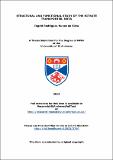Structural and functional study of the nitrate transporter, NrtA
Abstract
Membrane proteins play a crucial role in most cellular processes. Transporter
integral proteins carry a whole variety of solute molecules across biological
membranes. While the structure of thousands of soluble proteins has been
determined, very few integral membrane proteins have been solved. The structures
of several major facilitator superfamily (MFS) proteins that have been determined
revealed structural similarities but these proteins exhibit strict substrate specificity
and the structural and functional basis of this specificity is poorly understood. In
this study, a membrane protein from the saprotrophic ascomycete Aspergillus
nidulans NrtA, which is involved in the nitrate transport was investigated. This
high-affinity nitrate transporter is a member of the MFS and shares similar
structural features to other MFS proteins that have been fully characterised. In
order to reach a better understanding of the function and the structure of NrtA
certain amino acids - that could play a critical role in nitrate transport - were
changed using oligonucleotide mediated site-directed mutagenesis. NrtA
homologue sequences facilitated the identification of certain conserved and highly
conserved amino acids for mutational studies. Alanine scanning mutagenesis was
used to analyse highly conserved glycine residues in the conserved NRT2 motif,
which were found to play important roles but not essential as mutants were able to
uptake nitrate. Three other residues located adjacent to this highly conserved motif
were also analysed, revealing that a phenylalanine at position 457 probably play an
important, albeit not crucial, structural role, an asparagine at position 459 is critical
for NrtA function, whereas a leucine at position 460 is not essential. A comparative
study of NrtA residues that have been replaced by their residue-equivalent in NrtB
showed that a slight change in the hydrophobicity around TM2 highly conserved
arginine at position 87 and also around TM8 highly conserved arginine at position
368 can potentially be the cause of differences between NrtA and NrtB 6-fold rate
of transport and 10-fold affinity to nitrate. A variety of conserved and highly
conserved aromatic residues were analysed revealing a variety of roles. A residue
located at the proposed nitrate binding site was also analysed and substitutions to
other residues were not tolerated and no alteration to enzyme kinetics in mutant
N364Q was found when using the radioactive tracer ¹³NO₃⁻. Understanding the
role of certain amino acids on nitrate uptake should in turn enable development of
improved methods for the prediction of NrtA’s structure.
Type
Thesis, MPhil Master of Philosophy
Collections
Items in the St Andrews Research Repository are protected by copyright, with all rights reserved, unless otherwise indicated.

